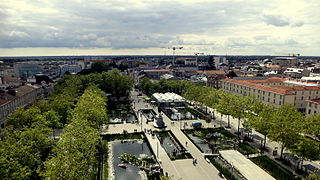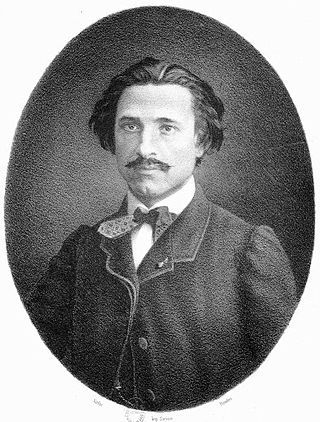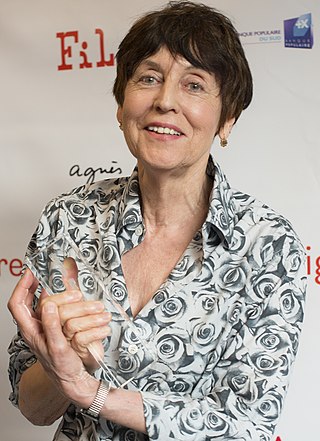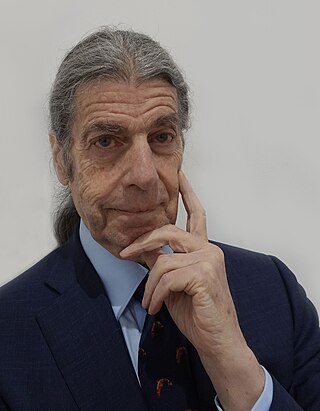Related Research Articles

Victor Burgin is a British artist and writer. Burgin first came to attention as a conceptual artist in the late 1960s and at that time was most noted for being a political photographer of the left, who would fuse photographs and words in the same picture. He has worked with photography and film, calling painting "the anachronistic daubing of woven fabrics with coloured mud". His work is influenced by a variety of theorists and philosophers, most especially thinkers such as Sigmund Freud, Henri Lefebvre, André Breton, Maurice Merleau-Ponty, Michel Foucault and Roland Barthes.

La Roche-sur-Yon is a commune in the Vendée department in the Pays de la Loire region in western France. It is the capital of the department. The demonym for its inhabitants is Yonnais.
James Lee Byars was an American conceptual artist and performance artist specializing in installations and sculptures, as well as a self-considered mystic. He was best known for his use of personal esoteric motifs, and his creative persona that has been described as 'half dandified trickster and half minimalist seer'.

Mihael Milunović is a Serbian and French painter. His work encompasses a wide range of artistic disciplines, from painting, drawing and photography through large-scale sculptures, installations, to sound, video and objects. His main interests focus on social and political issues. By decontextualizing everyday objects, symbols or situations, Milunović provokes unease in the observer, a blend of alienation and curiosity.

Paul-Jacques-Aimé Baudry was a French painter.

Sheila Hicks is an American artist. She is known for her innovative and experimental weavings and sculptural textile art that incorporate distinctive colors, natural materials, and personal narratives.

Candida Höfer is a German photographer. She is a former student of Bernd and Hilla Becher. Like other Becher students, Höfer's work is known for technical perfection and a strictly conceptual approach. From 1997 to 2000, she taught as professor at the Hochschule für Gestaltung, Karlsruhe. Höfer is the recipient of the 2018 Outstanding Contribution to Photography award, as part of the Sony World Photography awards. She is based in Cologne.

Ralf Winkler, alias A. R. Penck, who also used the pseudonyms Mike Hammer, T. M., Mickey Spilane, Theodor Marx, "a. Y." or just "Y" was a German painter, printmaker, sculptor, and jazz drummer. A neo-expressionist, he became known for his visual style, reminiscent of the influence of primitive art.

Annette Messager is a French visual artist. She is known for championing the techniques and materials of outsider art. In 2005, she won the Golden Lion Award at the Venice Biennale for her artwork at the French Pavilion. In 2016, she won the prestigious Praemium Imperiale International Arts Award. She lives and works in Malakoff, France.

Mangelos was a Yugoslavian artist, curator and art critic whose artistic production included handmade books, sculptures and paintings. His work and research contributed greatly to the development of abstract art in Croatia.

John Armleder is a Swiss performance artist, painter, sculptor, critic, and curator. His work is based on his involvement with Fluxus in the 1960s and 1970s, when he created performance art pieces, installations, and collective art activities that were strongly influenced by John Cage. However, Armleder's position throughout his career has been to avoid associating his artistic practice with any type of manifesto.

Goshka Macuga is an artist based in London. She was one of the four nominees for the 2008 Turner Prize.

Šejla Kamerić is a Bosnian visual artist.
Esther Shalev-Gerz is a contemporary artist. She lives and works in Paris.
Liz Deschenes is an American contemporary artist and educator. Her work is situated between sculpture and image and engages with post-conceptual photography and Minimalism. Her work examines the fluidity of the medium of photography and expands on what constitutes the viewing of a photograph. Deschenes has stated that she seeks to "enable the viewer to see the inconstancy of the conditions of display, which are always at play but sometimes hard to see." Her practice is not bound to a single technology, method, process, or subject, but to the fundamental elements of photography, such as light, paper, chemistry, and time.
Ellen Kooi, is a Dutch artist and photographer, who lives and works in Haarlem, Netherlands. She makes scenographic, theatrical imagery merging landscapes and figures–in the tradition of the city's landscape painters from the Dutch Golden Age.

Svetlana Kopystiansky is an American artist, active in New York City since 1988. She has a multimedia practice, including painting, photography, film, and video, with an investigation of language as her primary paradigm. On works in media of film and video, she collaborates with her husband Igor Kopystiansky. Her independent works and their joint works are shown internationally and held in museum and private collections around the world. Archives by Igor and Svetlana Kopystiansky are located at the Centre Pompidou, Kandinsky Library.
Latifa Echakhch is a Moroccan-French visual artist. Working in Switzerland, he creates installations. She participated in the Venice Biennale in 2011 and won the Marcel Duchamp Prize in 2013.
Dora Budor is a Croatian artist who lives and works in New York. She has exhibited extensively throughout the U.S. and Europe.
Danica Dakić in Sarajevo) is a Bosnian artist and university professor. She works primarily with video art, installation and photography. Her works have been widely exhibited, including at documenta 12 (2007) and at the 58th Venice Biennale (2019), where she represented Bosnia and Herzegovina. Dakić lives and works in Düsseldorf, Weimar, and Sarajevo.
References
- ↑ "Fariba Hajamadi | Centre Pompidou". www.centrepompidou.fr (in French). Retrieved 2020-03-07.
- ↑ Fricke, Harald (1997-05-12). "Karawane der Globalisierung". Die Tageszeitung: taz (in German). p. 14. ISSN 0931-9085 . Retrieved 2020-03-14.
- ↑ Smith, Roberta (1987-04-17). "Art: Annette Lemieux in 2 Mixed-Media Shows". The New York Times. ISSN 0362-4331 . Retrieved 2020-03-07.
- 1 2 3 Hajamadi, Fariba (1998). Fariba Hajamadi. Hajamadi, Fariba, Block, René, Museum Fridericianum, Ausstellung "Echolot oder 9 Fragen an die Peripherie" 1998.03.22-06.07 Kassel. Kassel: Museum Fridericianum. ISBN 3-927015-09-1. OCLC 246233302.
- 1 2 "Christine Burgin Gallery". www.christineburgin.com. Retrieved 2020-03-07.
- ↑ "Olivier Zahm on Fariba Hajamadi". www.artforum.com. 3 January 1994. Retrieved 2020-03-07.
- ↑ Decter, Joshua (1994). Fariba Hajamadi. France: musée municipal de la Roche-sur-Yon.
- ↑ Mary Ellen, Haus (1988). "Fariba Hajamadi". Artnews.
- ↑ Imbernon, Laurence; Decter, Joshua (1994). Fariba Hajamadi: [exposition], 1994, musée municipal de la Roche-sur-Yon. La Roche-sur-Yon: Musée municipal. OCLC 34504526.
- ↑ "Investigations 20: Fariba Hajamadi - ICA Philadelphia". Institute of Contemporary Art - Philadelphia, PA. 2013-08-30. Retrieved 2020-03-14.
- ↑ New York Magazine. New York Media, LLC. 1987-07-13.
- ↑ McCracken, David (September 14, 1990). "Chicago Tribune".
- ↑ "Grabrielle Salomon Art Conseil". Gabriellesalomon.com.
- ↑ "MAUREEN PALEY – PAST EXHIBITIONS 1984 — 2004" (PDF). maureenpaley.com.
- ↑ "4th International Istanbul Biennial". bienal.iksv.org. Retrieved 2020-03-14.
- ↑ Jorgensen, Ulla Angkjaer (August 2019). Exploring the Black Venus Figure in Aesthetic Practices. BRILL. pp. 178–182. ISBN 978-9004395206.
- ↑ Decter, Joshua (1994). Fariba Hajamadi: The Invention of Disappearance. France: Musée de la Roche sur Yon. ISBN 2908117428.